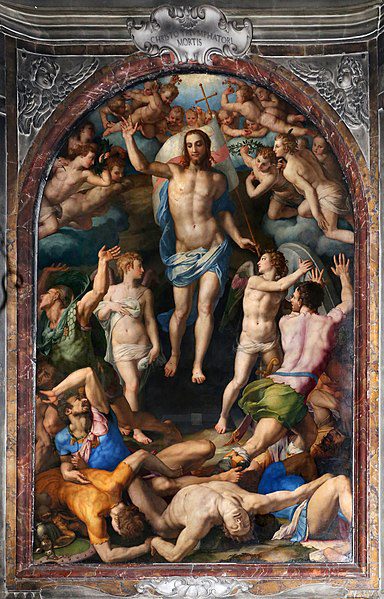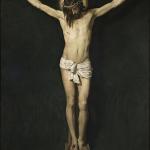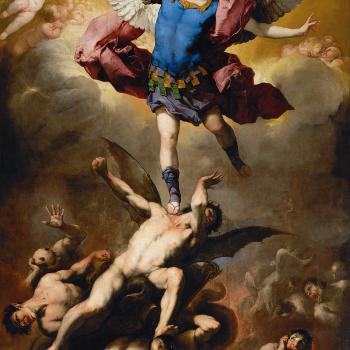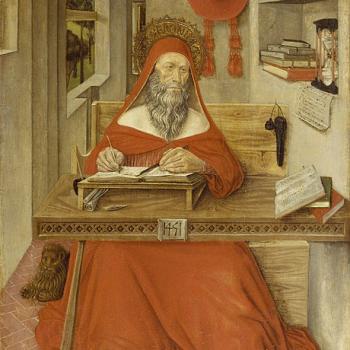Chapter 9 of my book (available for free online), Inspired!: 198 Supposed Biblical Contradictions Resolved. See the Introduction and ch. 1: How Do Atheists Define a “Biblical Contradiction”? All Bible passages RSV unless otherwise noted.
- How could Jesus be killed on a Friday and rise from the dead on Sunday, when Matthew 12:40 states: “so will the Son of man be three days and three nights in the heart of the earth”?
In Hebrew idiom, the phrase “one day and one night” meant a day, even when only a part of a day was indicated. We see this, for example, in 1 Samuel 30:12-13 (cf. Gen. 42:17-18). We know that Jesus was crucified on a Friday because Scripture tells us that the Sabbath (Saturday) as approaching (Matt. 27:62; Mark 15:42; Luke 23:54; John 19:31). The “day of preparation” is Friday, the day before the Sabbath: Saturday, and the Sabbath was considered to begin on sundown on Friday, as with Jews to this day. We also know from the biblical data that the discovery of his Resurrection was on a Sunday (Mark 16:1-2, 9; Matt. 28:1; Luke 24:1; John 20:1). And we know that “three days and three nights” (Matt. 12:40) is synonymous in the Hebrew mind and the Bible with “after three days” (Mark 8:31) and “on the third day” (Matt. 16:21; 1 Cor. 15:4). Most references to the Resurrection say that it happened on the third day. In John 2:19-22, Jesus said that he would be raised up in three days (not on the fourth day). It would be like saying, “This is the third day I’ve been working on painting this room.” I could have started painting late Friday and made this remark on early Sunday.
For both the ancient Jews (6 PM to 6 PM days) and Romans (who reckoned days from midnight to midnight), the way to refer to three separate 24-hour days (in whole or in part) was to say, “days and nights.” We speak similarly in English idiom – just without adding the “nights” part. For example, we will say that we are off for a long weekend vacation, of “three days of fun” (Friday through Sunday or Saturday through Monday). But it is understood that this is not three full 24-hour days. Chances are we will depart part way through the first day and return before the third day ends. For a Saturday through Monday vacation, then, if we leave at 8 AM on Saturday and return at 10 PM on Monday night, literally that is less than three full days (it would be two 24-hour days and 14 more hours: ten short of three full days). Yet we speak of a “three-day vacation” and that we returned “after three days” or “on the third day.” Such descriptions are casually understood as non-literal. The ancient Jews and Romans simply added the clause “and nights” to such utterances, but understood them in the same way, as referring to any part of a whole 24-hour day. Thus the supposed “problem” or so-called “biblical contradiction” vanishes.
- Was a great stone rolled in front of the tomb (Matt. 27:60; Mark 15:46), or was there no such stone (Luke 23:55; John 19:41)?
There was no stone yet in Luke 23:55 because this referred to the time when Jesus was placed in the tomb (see 23:53-54). When women went back two days later, they found the stone rolled away (24:1-2). John 19:41 simply doesn’t mention the stone, but in John 20:1 we learn that there was one, which was rolled away. Therefore, all four Gospels — taken together — note that the tomb had a stone in front of it, which was rolled away. This is not contradiction; rather, it’s complete harmony.
- Who witnessed this meeting (Matt. 27:62-66) when guards were sent to secure the tomb?
All it takes is one person, who communicated it to one or more of the evangelists or to oral traditions that helped formulate the Gospels. Two prime candidates were Nicodemus and Joseph of Arimathea, both Pharisees and followers of, or sympathetic to Jesus. The meeting included “the Pharisees,” after all. Simply because we can’t determine this with certainty from the texts alone, doesn’t mean or logically follow that there were none, or that this person or persons could not have communicated it. All it would take is one person at the meeting who was a follower of Jesus, or later converted to Christianity. This is not at all implausible.
- Was a guard placed at Christ’s tomb the day after his burial (Matt. 27:65-66), or was there no guard (Mark 15:44-47; Luke 23:52-56; John 19:38-42)?
The argument from silence doesn’t prove anything, and saying nothing about a particular event can’t possibly be contradictory to statements about said event because it has no content. Mark, Luke, and John would have to state something like “no guard was ever placed at the tomb” for this to be a real contradiction. And of course, they do no such thing. Therefore, it’s yet another pseudo-, bogus “contradiction.” One would think that logic (like fresh air, cute puppies, and the joy of ice cream) is something where Christians and atheists could readily agree with each other. But sadly, that’s not the case: at least not in the “1001 biblical contradictions” sub-group of anti-theist atheists.
- Did the two Marys visit the tomb (Matt 28:1), or both Marys and Salome (Mark 16:1), or several women (Luke 24:10), or only Mary Magdalene (John 20:1)?
Matthew didn’t mention Salome. So what? That’s of no relevance. In light of Luke, we can conclude that several women (more than the two Marys) saw the empty tomb (though not necessarily the risen Jesus). None of this is inexorably contradictory. Mary Magdalene could have told these other women about the tomb and also the fact that she had seen the risen Jesus. This implies repeated trips to witness the empty tomb, which was easy because it was right outside of town. As for John, he may be describing an earlier, initial visit by Mary Magdalene alone: perhaps indicated by “while it was still dark.” Then she went again with others. The text never states that “only Mary” went to the tomb, or that “Mary alone and no other woman” did so. Those are the sorts of words that would be required for an actual contradiction to be present. As it is, no contradiction has been established.
- Was it dawn when Mary went to the tomb (Matt. 28:1; Mark 16:2) or dark (John 20:1)?
Quite obviously, Mary Magdalene made an earlier pre-dawn visit, which appears to be the very first visit. It doesn’t take a rocket scientist to figure this out. Later on, several other women visited, along with her. But many skeptics seem to have the odd, inexplicable view that no one could have possibly visited Jesus’ tomb (where the greatest miracle in history had just occurred) more than once.
- Was the stone still in place when women visited Jesus’ tomb (Matt. 28:1-2), or had it already been removed (Mark 16:4; Luke 24:2; John 20:1)?
It is readily observed also that the women saw the stone already rolled away when they arrived, as reported in Mark 16:4, Luke 24:2, and John 20:1. So how does the believer in biblical inspiration explain away what seems at first glance to be a glaring contradiction in Matthew’s account? Well, as is often the case and necessity, one has to examine the Greek word(s) involved and also the tense. Matthew employs an aorist participle, translated in some English versions in the English past perfect tense. For example, Weymouth states that an angel “had come and rolled back the stone”; Young’s Literal Translation has “having come, did roll away the stone.” New American Standard Bible / Amplified Bible: “earthquake had occurred”; Williams: “Now there had been a great earthquake”; Wuest: “an angel of the Lord having descended out of heaven and having come . . .” It’s true that this is a minority of translations, but it’s significant, and shows that such a rendering is quite possible and permissible, according to the informed and educated judgment of these language scholars / translators. Moreover, the translations of Young, Wuest, and the Amplified Bible were specifically designed to bring out the precise and exact meaning of the Greek, including the sense of tense.
- Was an angel sitting on the stone at the entrance of the tomb (Matt. 28:2) or was a man sitting inside the tomb (Mark 16:5)?
There were two angels (they are often called “men” in Holy Scripture) or more present in or near the tomb: as specifically affirmed in Luke 24:3-4 and John 20:12. Or Matthew was referring to the specific time when the stone was actually rolled away. As explained over and over in this book, different accounts do not contradict unless they explicitly rule out any other event than what they describe. In this instance, there could have been one angel inside the tomb, and later, two; the same for outside the tomb, or one angel could be seen in the tomb and a second hidden from the observer, etc. Any number of scenarios are logically possible, and logical inconsistency cannot be proven.
- Did the eyewitnesses of the risen Jesus run to tell the disciples (Matt. 28:8), or tell the eleven and all the rest (Luke 24:9), or say nothing to anyone (Mark 16:8)?
Matthew and Luke are non-contradictory. The third statement is a well-known atheist canard, but it presupposes that Mark ends with that verse. It does not. It continues on to verse 20. Mark 16:9-20 is a disputed text among many Christians. That discussion is too complex and involved to delve into here, but if one accepts the arguments for the canonicity of Mark 16:9-20, then it’s consistent with the other Gospels and doesn’t contradict them. Even the words “they said nothing to any one, for they were afraid” (16:8) suggested only a temporary state, out of initial fear.
- Could Jesus be touched after his Resurrection (Matt. 28:9; Luke 24:39) or not (John 20:17)?
John 20:17 in KJV, which this particular atheist skeptic utilizes, has the phrase “Touch me not”. But that’s an unfortunate translation. RSV has “Do not hold me.” Baptist linguist A. T. Robertson, in his volume, Word Pictures in the New Testament (1930) explains it:
Touch me not (mh mou aptou). Present middle imperative in prohibition with genitive case, meaning “cease clinging to me” rather than “Do not touch me.” Jesus allowed the women to take hold of his feet (ekrathsan) and worship (prosekunhsan) as we read in Matthew 28:9.
Hence, almost all modern English translations have “hold” or “cling” or suchlike. And with this clarification, the supposed contradiction vanishes.
- How does Matthew 28:10 not contradict Luke 24:49, regarding Jesus’ instructions about what they should do when he rose from the dead?
In Matthew 28:10, Jesus tells his disciples to “go and tell my brethren to go to Galilee, and there they will see me.” The disciples did see Jesus in Galilee after he was risen (Matt. 28:16-17; John 21:1). In Luke 24:49 Jesus told them to “stay in the city, until you are clothed with power from on high.” This is “apples and oranges.” Matthew is talking about post-Resurrection appearances. Luke’s passage, on the other hand, which describes what occurred after what Matthew described, has to do with the Day of Pentecost, when the disciples received the Holy Spirit, which happened right in Jerusalem. It’s described by the same writer, Luke, in Acts 2:1-4 (cf. language of Luke 1:35; 9:1; see also the related passage Acts 1:8). In Acts 1:9, Jesus ascends to heaven. Likewise, in Luke 24:51, He ascends to heaven. Both passages describe the same event, and are written by the same author. Matthew and Luke + Acts, then, refer to completely different things. But it’s fascinating that this couplet is somehow thought to be a contradiction, isn’t it?
- How could the disciples doubt that Jesus had risen from the dead (Matt. 28:17), while the Pharisees and chief priests believed it possible (Matt. 27:62-66)?
“Some [not all] doubted” (as Matt. 28:17 states), and for a time, yes. It was the typical human skepticism regarding miracles, among “some” of the disciples. The enemies of Jesus believed no such thing. They called Jesus an “impostor” (Matt. 27:63) and the gospel and Christianity a “fraud” (27:64). They were worried that the disciples would “go and steal him away” (27:64) and fake his Resurrection, which is why they asked for a guard in front of the tomb. I search in vain for any “contradiction” here. It’s literally impossible for it to be a contradiction because this is referring to two completely different groups of men. What it actually is (if the challenge were actually accurate: which it isn’t) is a failed attempt to establish a significant oddity or anomaly (Pharisees believing in Jesus while his own disciples doubted him). The problem is that it does so by making a false blanket statement about the disciples and an equally untrue description of the Pharisees and their allies. This won’t do. It’s lousy, if not outright dishonest, argumentation. Seeking in vain to embarrass Christians and to mock the Bible, they only embarrass themselves, which is only poetic justice, from where we sit.
- Did Joseph of Arimathea boldly ask for the body of Jesus (Mark 15:43) or do so secretly (John 19:38)?
The two attributes aren’t mutually exclusive. One can be both bold and operate in secret. Every special forces raid is of such a nature, as is every clandestine espionage assignment. It was “bold” to ask Pilate (not the nicest guy) this, whether it was in secret or not. This is a classic example of a desperate, trumped-up alleged “contradiction.” But I can assure everyone that it’s authentic. Some skeptic came up with this. I didn’t invent it.
- Was Jesus laid in a nearby tomb (Mark 15:46; Luke 23:53; John 19:41) or in Joseph’s new tomb (Matt. 27:59-60)?
These things aren’t mutually exclusive. Matthew merely adds the information that it was Joseph’s own planned tomb. Someone not asserting a thing consistent with what it does assert, doesn’t contradict another asserting that same thing.
- How could the women expect to persuade the Roman guards to let them anoint Jesus’ body (Mark 16:1)?
This presupposes that the women knew there was a guard. They had observed Jesus being placed in the tomb on Friday (Mark 15:46-47; Matt. 27:57-61), but the guard was not posted till Saturday, the “next day” (Matt. 27:62).
- Did the women who saw the risen Jesus tell the disciples? Matthew and Luke make clear that they did so immediately. But Mark 16:8 states, “they said nothing to any one, for they were afraid.” Is this not contradictory?
In Mark 16:8, the risen Jesus had not yet been seen. But Mark 16:9-10 asserts: “he appeared first to Mary Magdalene, from whom he had cast out seven demons. She went and told those who had been with him.” Elsewhere I argued that Mary Magdalene first saw the risen Jesus earlier in the morning on Sunday. Matthew doesn’t declare that the women “immediately” told the disciples. It states, “they departed quickly from the tomb with fear and great joy, and ran to tell his disciples” (28:8). Therefore, a gap in time is possible that is harmonious with the data of Mark 16:8-10 and an earlier visit by Mary Magdalene. Likewise, Luke 24:10 reports that they “told this to the apostles” with no indication that it was “immediate.” No undeniable contradiction can be asserted, based on the false premise in the charge regarding Mark’s account, and the fact that all three accounts imply, prima facie, in my opinion, that the disciples were told fairly soon.
- Did the Ascension take place while the disciples were seated at a table (Mark 16:14-19), or outdoors at Bethany (Luke 24:50-51), or outdoors on the Mount of Olives (Acts 1:9-12)?
The account in Mark is an example of what is called “compression” or “telescoping”: literary techniques which were common, especially in ancient literature, and sometimes appear in the Bible. The text simply “jumps” to a future occurrence. It’s obvious that the disciples weren’t indoors watching the Ascension, for how could they see Jesus being “taken up into heaven” if so (Mark 16:19)? The present-day Bethany is located on the Mount of Olives, a little less than a mile from the Chapel of the Ascension. But Bible commentators note that it was the district of Bethany being referred to in Luke 24:50, which included the Mount of Olives. There was both a town and a district, just as is the case of my own present town in Michigan, which has a township around it with the same name. It was a system of toparchies, dating from the reign of Solomon We know this from the Old Testament, which contains (in RSV) the word “district” eighteen times in four different books (1 Kings; 2 Chron., Neh., Ezek.), including “district of Jerusalem” (Neh. 3:9, 12). Of particular note is Ezekiel 45:7, which refers to “the land on both sides of the holy district and the property of the city . . .” And in the New Testament, references to “district” (in Israel) occur six times in Matthew and Luke (e.g., “district of Caesarea Philippi”: Matt. 16:13). Mark 8:27 also references the “villages of Caesarea Philippi.”
- How could Luke know about Jesus talking to Herod during his trial (Luke 23:7-12)? And these speeches seem to have been remarkably well-preserved.
What an odd choice of example, since “chief priests and the scribes stood by” (Luke 23:10) as did Herod’s “soldiers” (Luke 23:11). All it would take was one or two of these (perhaps one who was a Christian or later became one) to report about this encounter, which entered into either oral tradition or directly into one of the Gospels. But as it is, Luke records not a single word that Herod said (so much for an absurdly alleged “remarkably well-preserved” verbal account); he only notes that “he questioned him at some length” (Luke 23:9). Since only Luke reports this incident, there was no secret or “miraculous” knowledge involved. All that is reported is that Herod questioned Jesus. We’re supposed to believe that no follower of Jesus could have possibly known that that happened? It’s ridiculous. It took only one follower to follow the irate persecuting crowds with Jesus from a distance and see them enter into Herod’s palace.
- Did the women buy burial materials before the Sabbath (Luke 23:56) or after (Mark 16:1)?
Luke 23:56 doesn’t assert this. It says they “returned [back home], and prepared spices and ointments.” Then they brought them to the tomb on Sunday (Luke 24:1; Mark 16:1). Pondering this sterling example, one wonders whether this biblical skeptic even read the passages in his or her zealous rush to find a “gotcha!” contradiction to embarrass Christians with. This one abysmally fails as an objection, and so do all the others detailed in this book.
- Were the disciples frightened when they saw Jesus (Luke 24:36-37) or glad when they first saw him (John 20:20)?
In Luke it was because they (just two of them, not “the disciples”) “supposed that they saw a spirit”: an event which almost always causes fear in recorded instances in Scripture. Then Jesus showed them his hands and feet (24:39) and they settled down. The text gives no indication of this being the first time they saw the risen Jesus. In John (a different incident, and seemingly the first time, in context) they were glad for the same reason: because he “showed them his hands and his side”: quickly proving that he was Jesus, so they wouldn’t be afraid. The text informs us: “Then the disciples were glad . . .” No contradiction exists, once the texts are actually analyzed and examined more closely (which the atheist skeptics, alas, never seem to have the time and/or desire to do).
- Was Jesus’ body anointed (John 19:39-40) or not (Mark 15:46 to 16:1; Luke 23:55 to 24:1)?
Mark and Luke don’t deny that Jesus’ body was anointed. If they don’t, there is no necessary contradiction. I submit that the women simply weren’t aware that at least some spices had been applied (as indicated in John 19:39-40). In any event, no contradiction has been proven.
- Did Nicodemus prepare Jesus’ body with spices (John 19:39-40) or, failing to notice this, did the women bring spices later (Mark 16:1; Luke 23:55-56)?
What happened is (humorously) explained right in the challenge! The women failed to see that Jesus’ body was prepared with spices, because the Sabbath was quickly approaching (John 19:42) — during which time this work would be disallowed –, so that they probably concluded that there hadn’t been enough time for such preparation. The women saw that Jesus was laid out with a linen shroud (Luke 23:53-55), but wouldn’t necessarily know if he had been anointed with spices. Therefore, they prepared the spices and ointments (23:56) and returned after the Sabbath to apply them (24:1).
- If Mary’s tomb visit (John 20:1) was earlier than the visit described in Matthew, why did she not encounter any guards?
Because, as the same passage states, she “saw that the stone had been taken away from the tomb.” An angel had already removed the stone and as a result, “the guards trembled and became like dead men” (Matt. 28:4). Presumably they also fled as a result (likely for fear of their lives, for the penalty for not properly guarding something was death in Roman law); therefore, Mary didn’t see them.
- Did Peter did go into the tomb, while another disciple stooped and looked inside (John 20:3-6), or did he not enter the tomb and only stoop to look inside (Luke 24:12)?
Luke 24:12 is a disputed verse, not found in the earliest manuscripts, which is why RSV doesn’t even include it. In other words, it can’t be considered as part of the New Testament. Therefore, it’s irrelevant to the discussion of consistency of accounts or reputed lack thereof.
- Did the women stay outside the tomb (John 20:11) or enter it (Mark 16:5; Luke 24:3)?
John refers to Mary’s pre-dawn visit alone, and doesn’t refer to multiple “women” (the alleged charge is incorrect in that way), but only to Mary Magdalene. Mark and Luke refer to another visit of Mary Magdalene with other women (Mary the mother of James, and Salome: Mark 16:1, and “Joanna and Mary the mother of James and the other women with them”: Luke 24:10), when (unlike Mary’s first visit) they did enter the tomb. It’s different things happening at different times and hence, no contradiction. I know it must be frustrating for the skeptic (who is convinced of massive biblical “contradictions” yet can never find an undeniable one), but logic is what it is. I didn’t make it up.
- Did Mary Magdalene first see the risen Jesus at the tomb (John 20:11-15) or on her way home (Matt. 28:8-10)?
I propose that John records a pre-dawn Sunday visit by Mary Magdalene, which was the first recorded post-Resurrection appearance of Jesus to anyone. She returned later with other women and they all saw him. But the text in Matthew doesn’t claim that this was the first time she saw the risen Jesus.
- Was Jesus’ first Resurrection appearance right at the tomb (John 20:12-14) or fairly near the tomb (Matt. 28:8-9) or on the road to Emmaus (Luke 24:13-16)?
Mark doesn’t say one way or the other. The others don’t indicate that their account was the “first” appearance, so different harmonious chronologies are entirely possible to construct (and a “contradiction” impossible to undeniably construct).
- Did Mary Magdalene recognize the risen Jesus? Of course she would! She’d known him for years. Matthew says that she did. But John (20:14-15) makes clear that she didn’t. How can this be?
John also makes it clear that it was “early, while it was still dark” (20:1). The same “dark” scenario is described in 21:4: “Just as day was breaking, Jesus stood on the beach; yet the disciples did not know that it was Jesus.”
- Why was the stone rolled away if Jesus could enter locked rooms (John 20:19)?
It wasn’t rolled away so Jesus could “get out,” but rather, to be a graphic visual demonstration that he rose from the dead.
- Were there, at the time of the Ascension, about 120 Christian brethren (Acts 1:15) or about 500 (1 Cor. 15:6)?
Acts doesn’t claim that that is the entire number of Christians in the world; only the amount in that place, who were living together. It’s sheer speculation to assert otherwise. Jesus appeared for forty days after he rose again (Acts 1:3), and so 500 Christians could have easily existed by the end of that period, seeing how wildly enthusiastic the early Christians were to spread the Good News of his Resurrection. 500 doesn’t contradict 120, as long as the latter is not stated to be the sum total of all Christians. Paul doesn’t say 500 is the grand total, either.
- Did twelve disciples see the risen Jesus (1 Cor. 15:5), or eleven: Thomas not being present (Matt. 28:16-17; John 20:19-25)?
In 1 Corinthians, either it was after the departed (and dead) Judas’ replacement with Matthias (Acts 1:20-26), so there were again twelve, or the title “twelve” was being used as a description of the group, which is done several times in the New Testament (including in John 20:24). Matthew 28 describes a time right before Jesus’ Ascension, before Judas had been replaced. Hence, “eleven” is used in the text (including Thomas). John uses “twelve” as the group title, even though Judas had by then departed, and there would have been literally eleven disciples, and ten without Thomas (John 20:24 again). No problem here (as always). In English usage, we also sometimes describe groups with a certain number, which isn’t literal. For example, the Big Ten Conference in NCAA (college) football actually has fourteen members. It began with ten. Yet it continues to be called “Big Ten” and not “Big Fourteen.” Is that a “contradiction”? No; it’s not literal, figurative usage, and non-literal language in a well-known established title. And so it was like this with the disciples in some passages, because they were first (and famously) numbered twelve.
- How come Paul only mentions that Jesus was “buried” (1 Cor. 15:4) and doesn’t mention an empty tomb?
This is one of the more bizarre charges (and, like all of these, was actually brought up by a real, live atheist (whose name shall be kept secret for the sake of charity). Right after Paul noted that Jesus was buried, he added, “he was raised on the third day in accordance with the scriptures, and that he appeared to Cephas, then to the twelve. Then he appeared to more than five hundred brethren at one time . . .” (1 Cor, 15:4-6). In Colossians 2:12 he states that “God, . . . raised him from the dead.” That is an empty tomb. He already mentioned that he was buried. In order to rise from the dead and to appear to others in many different places, the tomb necessarily (by virtue of logic) had to be empty. In Acts 13:29-31 Paul wrote: “they took him down from the tree, and laid him in a tomb. But God raised him from the dead; and for many days he appeared to those who came up with him from Galilee to Jerusalem . . .” There’s the tomb: specifically mentioned. And if Jesus appeared risen in Galilee, he could hardly have still been in his tomb, could he? This is an exceedingly odd objection. There are many many more references to Jesus’ Resurrection in Paul’s writings (Acts 17:2-3, 30-31; 26:22-23; Rom. 1:4; 4:24-25; 6:4-5, 9; 7:4; 8:11, 34; 10:9; 1 Cor. 6:14; 15:3-8, 12-17, 20; 2 Cor. 4:14; 5:15; Gal. 1:1; Eph. 1:20; Phil. 3:10; 1 Thess 1:10; 2 Tim 2:8).
- Was Jesus first seen by Cephas (Peter), then the other ten disciples (1 Cor. 15:5), or by the two Marys (Matt. 28:1, 8-9), or by Mary Magdalene (Mark 16:9; John 20:1, 14-15), or Cleopas and others (Luke 24:17-18), or the disciples as a group (Acts 10:40-41)?
1 Corinthians doesn’t claim that he “first” appeared to Cephas, but that he appeared to him before he appeared to the other disciples: a completely different proposition. Peter is singled out as a witness not because he was the absolutely first person to see the risen Jesus, but rather, because he was the leader of the disciples and the early church (see the first half of the book of Acts). Mark 16:9 actually does expressly affirm that Mary Magdalene was the “first.” And so she was. John’s account is consistent with that notion. Does Matthew contradict this because of the second Mary? Not necessarily. Many scenarios can be easily imagined that instantly harmonize the passages. For example, maybe “the other Mary” happened to be looking away when the risen Jesus suddenly “met them”, so that Mary Magdalene was, technically, the first to see Him. Or Jesus met Mary Magdalene with no other women around, and then Matthew 28:9 records a second instance of his appearing to her, except with another woman, too. Luke 24 has the story of the two men on the road to Emmaus. Nothing definitely indicates they were the first; indeed, they could not have been because other Gospels record Mary Magdalene and the other Mary seeing Jesus early in the morning on the first Easter Sunday, whereas in this account it is said that the time was “toward evening” with the day being “far spent” (24:29). Acts states that the disciples were in the select group to whom Jesus appeared, as opposed to “all the people.” But it doesn’t say they were absolutely the first, and doesn’t therefore rule out Mary Magdalene being the first person, which is expressly stated in Mark. Conclusion?: all of these passages are perfectly harmonious and pose no problem for biblical infallibility or self-consistent accuracy and trustworthiness.
*****
*
Photo Credit: Resurrection of Christ, by Agnolo Bronzino (1503-1572) [Wikimedia Commons / Creative Commons Attribution 3.0 Unported license]
***
Summary: Ch. 9 of Dave Armstrong’s book, “Inspired!”: in which he examines 198 examples of alleged biblical contradictions & disproves all of these patently false claims.














